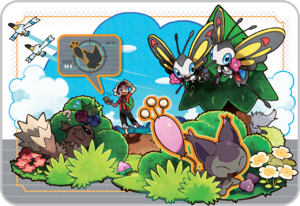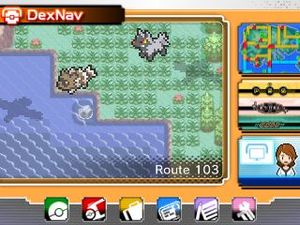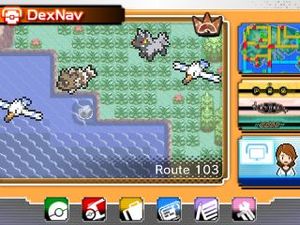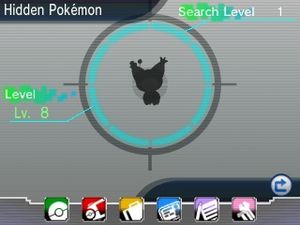DexNav: Difference between revisions
(This page ended up a lot bigger than I intended to make it. Note that I coined the term "view" since I couldn't find any official descriptor.) |
(No difference)
|
Revision as of 11:58, 26 November 2014
The DexNav (Japanese: ずかんナビ Dex Navi) is an application on the PokéNav Plus in Pokémon Omega Ruby and Alpha Sapphire. It is used to analyze wild Pokémon in the player's current location.
Catching progress view
The catching progress view is the default view of the DexNav. This view only uses the normally allocated screen space for PokéNav Plus applications, so the tabs for the other applications are still visible, allowing the player to switch to the other applications.
This view displays the menu sprites of wild Pokémon in a particular area that the player has owned, and silhouettes of the menu sprites of wild Pokémon that the player has seen (the player does not have to have encountered these Pokémon in this location for them to appear here). These sprites are placed on an image rendered using Generation III tiles unique to that particular area; Pokémon that appear in the water are placed over water areas (no distinction is made between surfing and fishing encounters, nor different rods), while Pokémon encountered in tall grass are placed over tall grass.
This view also displays the name of the current location in the bottom right hand corner.
Pokémon that appear in the water will not appear in the catching progress view unless the player has a fishing rod or Surf. Pokémon that can only be encountered in the water by fishing will not appear in the water on the catching progress view unless the player has a fishing rod; Pokémon that can only be encountered in the water by surfing will not appear in the water on the catching progress view unless the player has Surf.
Different rooms of caves and buildings are considered separate areas by the DexNav.
If no wild Pokémon appear in a particular location, a red background with an image of a Poké Ball logo and a Pikachu menu sprite are displayed. Tapping anywhere on the DexNav screen will display the message "There are no wild Pokémon in this area."
Mark of completion
If the player has owned all wild Pokémon that can appear in a particular area by particular methods, the DexNav will display a crown as a mark of completion in the top-right-hand corner of the DexNav while in that area dependent on the number of encounter types the player has owned all possible wild Pokémon from. The three methods are as follows:
- Tall grass or cave encounters (including by Horde Encounters)
- Fishing (no distinction is drawn between different rods)
- Surfing
If the player has owned all wild Pokémon that can appear in a particular area by all of the listed methods that are possible in that particular area, a gold crown will appear on the DexNav while in that area.
If the player has owned all wild Pokémon that can appear in a particular area by two of three possible methods, a silver crown will appear on the DexNav while in that area.
If the player has owned all wild Pokémon that can appear in a particular area by one of three possible methods, a bronze crown will appear on the DexNav while in that area.
Tapping anywhere on the DexNav screen except the non-silhouetted menu sprites themselves (but including the crown) while there is magnifying glass present will display a message based on the number of Pokémon the player has obtained from a particular area. The message depends on the player's available methods for wild encounters, so will exclude Pokémon encounterable via surfing if the player doesn't have Surf, and will exclude Pokémon encounterable via fishing if they have no rods (although no distinction is drawn between rods for this purpose). If the player has obtained all the Pokémon they can with their available methods, the message "Good job! You've caught them all!" will be displayed. If the player has a significant portion of such Pokémon owned, the message "Nearly complete!" will be displayed.
Pokémon view
The Pokémon views are a collections of views of the DexNav. These views fill the entire touch screen, so the tabs for the other applications are not present, preventing the player from switching to the other applications.
These views display information about a particular Pokémon species or individual Pokémon, rather than displaying all the wild Pokémon that can appear in the area at once.
Nearby Pokémon
If a Pokémon is near the player in the overworld and there is no nearby hidden Pokémon, the DexNav will react. If the DexNav is in the Found Pokémon view, it will automatically change to the Nearby Pokémon view; if the DexNav is in the catching progress view, it will display a blinking magnifying glass centered in a blue circle; if it is not the active application, the DexNav tab will be overlain with a magnifying glass centered in a blue circle. If the player taps the DexNav while it is reacting in such a way while it is in the catching progress view, the DexNav will enter the Nearby Pokémon view.
If the player enters the Nearby Pokémon view, the Pokémon will be registered as seen in the Pokédex (if it isn't already). This also increases player's Search Level by 1. Specific overworld Pokémon such as Peeko will only increase the Search Level the first time they are registered, but generic overworld Pokémon such as the wild Wingull on Route 104 will increase the Search Level each time the player returns to the location.
This view displays the Pokémon's name, an image of the Pokémon, its type, and the player's Search Level for that Pokémon. This view also includes a button that takes to player directly to the Pokémon's Pokédex entry.
Found Pokémon
If the player taps a Pokémon's menu sprite on the DexNav while in the catching progress view, the DexNav will enter the Found Pokémon view.
This view displays the Pokémon's name, an image of the Pokémon, its type, and the player's Search Level for that Pokémon. This view also includes a button that takes to player directly to the Pokémon's Pokédex entry.
Additionally, a Search button appears below the Pokémon's image. Pressing this button activates the Search function.
Search function
The search function is a feature used to force specific Pokémon species that the player has owned to appear as hidden Pokémon. If the player presses the Search button on the Found Pokémon view, the DexNav may cause that species of Pokémon to appear nearby as a hidden Pokémon. If it does so, the player will immediately enter the Hidden Pokémon view; if it fails, it will display the message "It couldn't be found nearby. Try looking in a different spot!"
The search function is the only way to cause hidden Pokémon to appear on cave tiles or water tiles; however, in these cases these Pokémon will move around, rather than staying in one spot like hidden Pokémon in tall grass.
Hidden Pokémon
Hidden Pokémon occasionally appear in tall grass while the player is walking; these Pokémon can be selected from any of the Pokémon that can be found outside of Horde Encounters in tall grass normally. This is represented by the Pokémon making its cry while rustling around in a grass patch, typically with one of the Pokémon's appendages sticking out of rustling grass (often shadowed), although some Pokémon appear in different ways while rustling (such as Voltorb appearing as a yellow glow). Pokémon which normally only appear in Horde Encounters in that location will not appear at random.
The player can also force hidden Pokémon to appear with the search function. While hidden Pokémon normally only appear in tall grass, the DexNav can also cause hidden Pokémon to appear in water or on cave tiles. Pokémon that appear in tall grass will remain stationary, whereas Pokémon in water and on cave tiles will warp around the location. Pokémon in water must be encountered by Surf; fishing will ignore any appearance of a hidden Pokémon.
If a hidden Pokémon appears near the player, the DexNav will react. If the DexNav is in the Nearby Pokémon view or the Found Pokémon view, it will automatically change to the Hidden Pokémon view; if the DexNav is in the catching progress view, it will display a blinking magnifying glass centered in a red circle; if it is not the active application, the DexNav tab will be overlain with a magnifying glass centered in a red circle. If the player taps the DexNav while it is reacting in such a way while it is in the catching progress view, the DexNav will enter the Hidden Pokémon view.
This view displays the Pokémon's type and the player's Search Level for that Pokémon, and as the player gets closer to the Pokémon in question will also display the Pokémon's silhouette. Other information, such as the Pokémon's level, first move, Ability, held item and potential may also be displayed. If the Pokémon has a special move, Hidden Ability, high level, or high potential, an exclamation mark will appear next to that datum on the view. More information about the Pokémon will be displayed when the player's Search Level is higher for that particular Pokémon species.
Approaching
In order to approach a Pokémon without scaring it off, the player must sneak towards it; this is done by pushing the circle pad without pushing it all the way to the edge. It is not possible to sneak while cycling, running, using the Dowsing Machine, or using the D-pad. If the player is too close to the hidden Pokémon and jumps down a ledge, walks or runs, the Pokémon will be scared off.
Special qualities
Pokémon encountered as hidden Pokémon can have certain special qualities that Pokémon normally encountered in grass do not.
- They often have their normal first move replaced with a special move, randomly selected from the Egg moves of the Pokémon and its pre-evolutions.
- They can have their Hidden Ability.
- They can be up to 10 levels higher than the level they would normally be encountered at in the wild in that location.
- They can have held items they would not normally have.
At higher Search Levels, wild Pokémon are more likely to have these traits.
Search Level
The player has a separate Search Level for each different species of Pokémon. At higher Search Levels, the player is more likely to encounter Pokémon of that species with Hidden Abilities or special moves, and the Hidden Pokémon view will give more details. This value is also displayed in the Pokédex, but instead is named "Times encountered".
There are two ways to increase the Search Level:
- Encountering a specimen of that species (either in the wild or in a Trainer battle)
- Link battles do not affect this
- Every Pokémon that appears in a Horde Encounter counts individually
- Using the Nearby Pokémon view of the DexNav
In other languages
| |||||||||||||||||||||||||||
External links

|
This game-related article is part of Project Games, a Bulbapedia project that aims to write comprehensive articles on the Pokémon games. |





